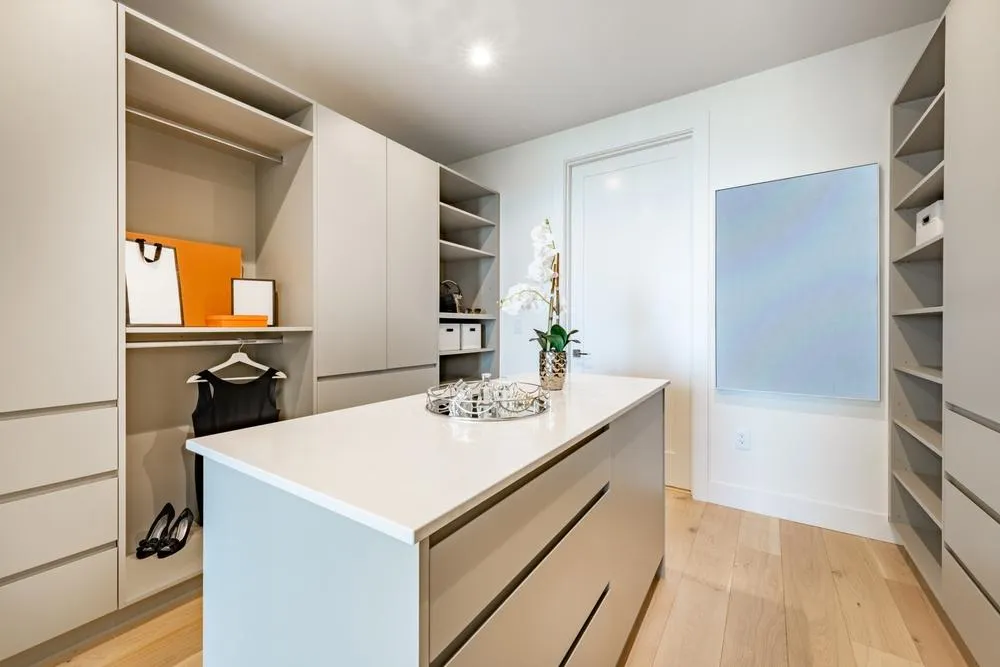
How To Convert Your Bath Into a Beautiful Walk-In Closet
Homeowners often overlook the potential of a rarely used bathroom, especially when storage needs start to outweigh bathing routines. Transforming a dated or unused bath into a walk-in closet can resolve space issues while increasing home functionality. No-demolition remodeling techniques simplify this conversion by preserving core structures and working around existing plumbing and walls.
Traditional renovations often require tearing down drywall, moving pipes, and reconfiguring the layout completely. With strategic planning and resurfacing techniques, professionals can convert the space into a stylish, efficient storage hub without demolition. Former vanities, tubs, and tile floors can all be upgraded or refaced to blend seamlessly with new cabinetry and closet systems. For homeowners seeking a budget-conscious solution with premium impact, the no-demolition path offers significant advantages.
How To Evaluate the Existing Bathroom Layout
Converting a bathroom into a walk-in closet starts with evaluating layout constraints and determining which structures can remain in place. Retaining core plumbing and walls keeps labor costs down and simplifies the project timeline. Most bathrooms offer enough square footage for wardrobe storage when the tub, toilet, or vanity area is repurposed thoughtfully. A detailed assessment helps identify the best zones for shelving, drawers, and hanging space.
Bathtubs and showers can often be removed without disturbing surrounding tile or flooring. Professionals use no-demolition refinishing to seal surfaces, patch gaps, or overlay quartz where needed. Existing cabinetry, such as vanities, can also be refaced to function as built-in storage for shoes, accessories, or folded items. Homeowners benefit from preserving structure while gaining fully customized interiors.
Electrical and ventilation requirements should be reviewed to ensure comfort and safety. Proper lighting enhances visibility while accentuating design choices like closet rods, mirrored doors, and drawer pulls. Bathroom ventilation systems typically exceed what’s required for closet use, meaning no upgrades are necessary. Keeping those systems intact reduces costs and shortens construction time.
A clear understanding of plumbing, flooring, and electrical positions ensures that closet systems can be installed without unexpected issues. Professionals often build around old drain lines or cap them discreetly beneath overlays. This approach avoids messy demolitions or prolonged bathroom closures. For homeowners with tight schedules, efficiency is just as important as the final design.
Removing Fixtures Without Demolition
Walk-in closet conversions require removing outdated bathroom elements without damaging the surrounding surfaces. Skilled teams can uninstall tubs, toilets, and vanities using careful, non-invasive methods that preserve the existing structure. Instead of ripping out tile or subflooring, they focus on clean extractions that prepare the area for refinishing or overlay installation. The goal is a damage-free foundation ready for new closet components.
Quartz overlays can cover leftover floor patches or unfinished sections where fixtures once sat. These overlays create seamless, low-maintenance surfaces that elevate the overall closet look. Unlike demolition-based methods, overlays eliminate the need to match replacement tile or rebuild drywall. The result is a smooth, continuous space that feels professionally designed.
Vanity cabinets that remain can be transformed with cabinet refacing, new drawer hardware, or added pull-out features. This reduces waste and keeps the project sustainable while adding essential storage. A previous sink cabinet can now hold folded garments, handbags, or jewelry organizers. Functionality improves without the need for costly custom carpentry.
Any plumbing connections that are no longer needed can be sealed or capped under overlays. This step ensures safety while keeping future flexibility intact if the space ever needs reconversion. Homeowners gain peace of mind knowing that no permanent structural changes were made. The bath-to-closet transformation remains both reversible and practical.
Designing Walk-In Closet Storage for Maximum Use
Once fixtures are removed and surfaces refinished, storage system design becomes the next critical step. A good walk-in closet should include hanging space, adjustable shelving, drawer storage, and accessory zones. Designers create modular solutions that adapt to the existing footprint while maximizing every inch of vertical and horizontal space. Customization allows the closet to suit personal wardrobe habits and storage needs.
Cabinet refacing extends to built-in storage pieces that serve as anchor points in the new closet layout. Previous bathroom cabinetry can be upgraded with new doors, drawer fronts, and soft-close hardware. Vertical storage towers can replace medicine cabinets, creating ideal shelving for sweaters, shoes, or baskets. Each element adds beauty and purpose without overwhelming the room.
Wall panels made from engineered surfaces can be added for hanging rods, integrated lighting, or slide-out accessories. These panels mount over tile or drywall and require minimal alteration to install. The result is a polished look that feels cohesive with the rest of the home. Owners appreciate how easily closet systems integrate with former bath structures.
Adding an island or seating bench depends on square footage, but even compact bathrooms can support custom solutions. Fold-down ironing boards, full-length mirrors, or jewelry pull-outs fit seamlessly into refaced cabinetry. Thoughtful design ensures the space supports both daily use and long-term organization. A well-planned closet increases comfort, efficiency, and home value.
Flooring and Wall Finishes That Complement the Closet
Most bathroom floors are tile, stone, or vinyl—materials chosen for water resistance rather than comfort. Converting to a closet gives homeowners the opportunity to upgrade the look and feel of the space. Quartz overlays can refresh tile without demolition, offering a warmer tone and consistent texture. These surfaces are easier to clean and maintain while elevating closet aesthetics.
Bathroom walls often feature moisture-resistant paint or tile halfway up the wall. Wall panels or fresh paint in a softer tone can replace that cold, clinical look. Professionals install overlays or custom wall finishes directly over tile or plaster with no need for full removal. This process gives the room a cohesive, updated design with minimal waste or mess.
Cabinet finishes and trim details can also be updated to reflect the homeowner’s preferred aesthetic. Refaced cabinets come in wood tones, matte colors, or high-gloss finishes to suit various closet styles. Even former towel bars or hardware can be replaced with streamlined, modern handles or hooks. Every detail contributes to the space’s new purpose and visual appeal.
For homeowners converting a master bath, matching the new closet finishes to the bedroom design ensures a fluid transition. Cohesive color palettes and surface materials help unify the look across both rooms. Without needing demolition or reconfiguration, the closet begins to feel intentional and well integrated. Comfort and elegance combine in a space designed entirely around lifestyle needs.
Lighting, Mirrors, and Final Touches For Your Walk-In Closet
Lighting plays a crucial role in walk-in closets, especially those converted from windowless bathrooms. Installing LED strips, ceiling fixtures, and integrated cabinet lights creates a bright, flattering environment. Professionals often utilize existing electrical connections for lighting upgrades, avoiding the need to rewire walls. Efficient, well-lit spaces make daily routines smoother and more enjoyable.
Mirrors also serve both functional and decorative purposes. Full-length mirrors mounted on doors or walls aid in outfit planning and add visual depth. Medicine cabinets or vanity mirrors can be replaced with mirrored panels that complement closet design. Refacing frames or adding lighting enhances their appearance without replacement.
Small touches such as drawer organizers, custom closet rods, or slide-out hampers complete the space. Refacing professionals can incorporate these features during the installation phase, ensuring each element aligns with overall design goals. Every storage solution serves a clear function and fits within the original bathroom footprint. No space goes unused or underutilized.
Decor and soft finishes like rugs, upholstered benches, or art personalize the converted space. Though originally built for hygiene, the room transforms into a place of comfort and self-care. A successful closet conversion balances storage with luxury in a way that fits daily life. For many families, the bath-to-closet transition becomes one of the most satisfying updates in the home.
Upgrade Storage with Smart, No-Demo Remodeling
Transforming an underused bathroom into a walk-in closet is both practical and rewarding with the right approach. No-demolition remodeling techniques allow homeowners to preserve existing surfaces while achieving a fresh, tailored design. Whether updating cabinets, resurfacing walls, or designing custom storage, professionals deliver results without the stress of full-scale renovation. For time-conscious homeowners, it’s a renovation that works with real life.
Explore your options for a walk-in closet conversion at Kitchen and Bath Transformations, where experts in no-demolition remodeling make beautiful upgrades possible.


